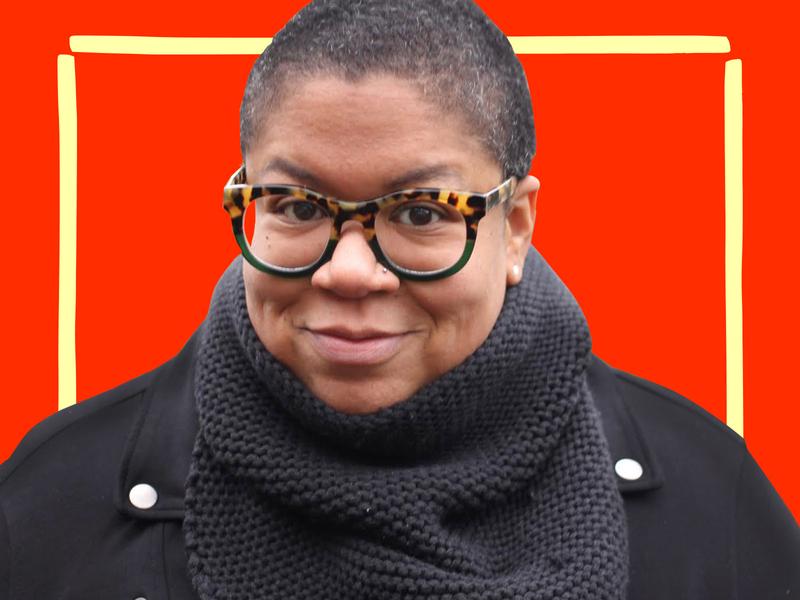The Writing on the Wall

( Courtesy of the Artist )
EPISODE 10: THE WRITING ON THE WALL
[sound of classroom]
Ellen Davis: So, guys, this is an artwork that was made in 2004...
So we’re standing just outside a classroom at MoMA, surrounded by high schoolers, about 15 of them. I’ve been invited to sit-in on an art class. At the front is Ellen Davis - I talked to her before, in the episode about Monochromes and that unbelievably blue Klein painting she was restoring. Now Ellen is playing the role of teacher. And the students are all standing there, each with a marker in their hands. It’s pretty freaking cute.
Ellen Davis: So we're going to be making a piece on this wall that's called wall drawing 797.
It’s by the artist, Sol LeWitt.
Ellen Davis: I'm just going to read you the instructions for the piece --
LeWitt wrote instructions -- directions that other people would use to make a painting or drawing on a wall.
Ellen Davis: The first drafter has a black marker and makes an irregular horizontal line near the top of the wall. Then the second drafter tries to copy it, without touching it, using a red marker. … (fade under)
These kids are going to make a Sol Lewitt. They’re going to draw directly on the wall and make a Piece of Work [laughter]. See what I did, right there?
Ellen Davis: (fade up)... Then the second drafter followed by the third and fourth copies the last line drawn until the bottom of the wall is reached. So can any of you kind of envision what this thing is going to look like?
Teen 1: It'd be like, horizontal lines, I guess. Is it like that kind of?
Ellen Davis: Yeah. Except the first drafter makes an irregular horizontal line. So you know when you're kind of bored in class and you like make a shape and then like draw lines that match it across the page, not that you guys are doodlers or anything but it's kind of like that. But it's going to be different every time depending on whoever does that first, all important irregular horizontal line. So somebody is going to have to take responsibility for that.
And to choose that somebody…
Student 1: Heads or Tails. Now.
Student 2: Heads.
… flip a coin, obviously.
Student 3: OK. I'm not good at this but.
Student 1: Just throw it on the ground.
[coin sound]
Student 2: Heads
Amanda won! Ok, so they all go over to the wall -- it’s probably, I dunno, 12 by 12.
Ellen Davis: So we're just going to go like to the right of that and don't draw on the elevator side because I may get fired.
Amanda: What if we wanted to go right to left?
Ellen Davis: Oh, Lefty.
Amanda: I mean does he give instructions?
Ellen Davis: I guess you define it. You're the boss here.
[sound of marker on wall]
An hour later, they’ve filled the wall. It looks like a multi-colored waterfall. And it’s definitely a Sol LeWitt.
Amanda: Since he came up with the actual concept and he's the artist too, but this I feel like this is like a communal work of art. So whoever is working on it is also, in part, the artist.
[MUSIC]
This is “A Piece of Work.” I’m Abbi Jacobson.
And this episode is all about… words. They’re everywhere, on paper, on buildings, in our text messages.
They tell us what to do, they communicate ideas, but can words -- just words -- be... art?
Mark Epstein: This piece is so good. I love this piece.
This is Mark Joshua Epstein, he’s a teacher at MoMA -- and he’s also a painter.
Mark Joshua Epstein: He was just like it's called Broken Bands--what is it called?--Broken Bands of Color in Four Directions. And that's the whole piece, that's the instruction for the piece. And then you have this. It's crazy.
He’s showing me this other piece by Sol Lewitt called “Wall Drawing #1144, Broken Bands of Color in Four Directions.”
I’m gonna try to describe what I’m seeing if you guys just-- it’s gonna take a second. It has 4 sections. Each section is filled with rectangular blocks that are red, yellow, blue, green, purple, and orange: think Legos.
And they’re stacked in different directions: in one panel they’re vertical, in another, they’re horizontal, and in the other two panels they’re diagonal.
And, all together, this piece is gigantic -- it’s almost 40 feet long. It runs the whole length of this an entire hallway.
Abbi: What is it with?
Mark Joshua Epstein: What is it made from?
Abbi: Yeah.
Mark Joshua Epstein: I'm going to run to the label one more time. The label's fancy so it calls it synthetic polymer paint, which is probably just like latex wall paint or acrylic paint. What do you think about it?
Abbi: I love it. I love all of his work. I love how graphic it is.
Mark Joshua Epstein: it's so satisfying to look at this work. I mean it's it's amazingly, the scale is beautiful. I am like a junkie for flat color geometry, something that looks organized because my life is insane. Um, this work also infuriates people.
Abbi: Really.
Mark Joshua Epstein: Oh yeah. When you say to a group of people "oh and he didn't make this.”
Abbi: Right.
Mark Joshua Epstein: People go crazy.
But it also wasn’t installed by just any random person.
When a museum wants to officially show a wall drawing by Sol LeWitt, first they have to get an official certificate with instructions and a diagram. Then the LeWitt estate sends a group of specifically qualified people to follow those instructions, and paint it on the wall - just so.
Mark Joshua Epstein: What's interesting to me about it is, so in 1968 he decided to start making these instructional pieces. And with the idea that it kind of leaves it open to interpretation, right. People interpret words differently, people draw lines differently.
Abbi: It is interesting if you know like say someone at San Francisco MoMA wanted to do this exact thing and they didn't use the same materials, it would be a different piece because like the orange would be different and is he, was OK with that?
Mark Joshua Epstein: In theory he was OK with that. I don't know how OK the estate is with that. But in theory like these four panels could be in a different order, right.
Abbi: ‘cause that's like more exciting to me.
Mark Joshua Epstein: But what's happened now: he died in 2007 and I think what's especially happened since his death is these pieces have been almost canonized. And so, there's a certain pen and a certain pencil and a certain way you push and certain everything and they're looking at pictures and diagrams and it, to me, almost feels like some of the magic of the variations and interpretation of the instructions have been lost because now a Sol LeWitt has to look like a Sol LeWitt.
Abbi: Right. It was always formulaic but now it's become even more so because it's just done more.
Mark Joshua Epstein: There's like the way it's done. It is like so precise and so kind of just has to be done in such a way. But none of that is really contained in the instructions. It's been added on.
Abbi: It reminds me also I was in a artist's studio. A pretty well known artist, I'm not going to say who it is.
Mark Joshua Epstein: Mystery.
Abbi: And I've never I had never really been in like an artist that was like making work that was like selling in that way that was like a working place. And I knew this but I had never experienced it. Like, they had all these assistants working on their paintings, other paintings at the same time. All these really well known prolific painters oftentimes have these assistants that are doing like the bottom layers or they're doing the washes or they're doing these things and they're not discounted for their work so why is this any different?
Mark Joshua Epstein: You know it happened in the Renaissance. It's the same idea of like having a workshop.
Abbi: I guess it's like the same thing as like an architect gets all the credit for the building but they didn't build the fucking building.
Mark Joshua Epstein: Yeah, I mean it's tricky business. I think.
Abbi: Right? You're like oh I had a big part in this.
Mark Joshua Epstein: Yeah, and certain artists will credit their assistants like...
Abbi: I see.
Mark Joshua Epstein: ...on the wall label, which is really amazing.
And he does too -- this one was made by Rob Nelson, Anthony Sansotta, Irene Stevens, and Mitsuyo St. Clair.
Good job, guys. I mean, it really looks great.
Abbi: When did he start doing the instructions for it? Like cause I'm assuming it was just him doing them and at a certain point and then he decided, oh this would be interesting to have it be almost interactive.
Mark Joshua Epstein: What I've read is that in 1968 he decided to start making these conceptual pieces which just existed as instructions. And I think, some of them just existed as instructions for awhile. I don't think that he was writing the instructions and then necessarily making them.
Abbi: So he never really did.
Mark Joshua Epstein: I don't think he was out making them. I think he kind of developed them. People also talk about him a lot as like a composer, and the composer is composing a score and then the score is being played by an orchestra.
Abbi: Yeah.
Mark Joshua Epstein: But it's interesting because like when like a Bach Cello Concerto is played by Yo-Yo Ma, you're not just like come see the Bach Cello Concerto. It's like, come see Yo-Yo Ma, right.
It’s like being an actor and having a script. There are words and stage directions to work with -- like, creative constraints. And that sort of clarity can be really helpful as an artist.
Mark Joshua Epstein: I mean sometimes I think it's a relief to be led. It's a relief. You know in my own studio I talk about like decision time versus no decision time and that's just about like whether I'm filling in a large space of pattern, that's no decision time. Decision time is OK what do you do next? And it's much more frightening to go to the studio and know that it's going to be six hours of decision time. If it's six hours of no decision time, it's like awesome. Let's like listen to a podcast and hang out. And like you know eat a salad and do this, no decision time. I think it's similar like when people, we were talking, when people come to the museum and they don't know kind of what they're supposed to quote unquote supposed to get from an artwork, if you have instructions or someone is telling you to do something, and you're the artwork, I feel like even me I'm in museums all the time. It's still it is like goosebump inducing. Are these things that quote unquote teach you how to draw a bunny or draw this, is that empowering or is that is that sort of reducing your creative output?
This is something that Mark has been thinking about for a long time.
Mark Joshua Epstein: I also like I had a huge fight with my parents when I was a kid because they wouldn't let me do paint by numbers because they thought that it would inhibit my creativity. They won. I'm a practicing painter in New York. It worked.
Coming up … what if you take a bunch of words and literally put them up on a wall?
This is A Piece of Work.
>>>>> MIDROLL <<<<<
[MUSIC]
Abbi: What’s up, I haven’t seen you in like --
Samantha Irby: I know! I just want to talk to you about like --
Abbi: We need to like catch up for real. We only talk on the phone.
Samantha Irby: How long are you here?
Abbi: I live here!
Samantha Irby: Yeah, but you’re like never here.
Abbi: Wait -- how long are you here?
Samantha Irby: Until Saturday!
Abbi: You are? Okay, but I can only hang out tomorrow.
Samantha Irby: Okay!
This is my friend Samantha Irby. She’s a writer, and one of the funniest people I know.
Abbi: You're here technically on a book tour.
Samantha Irby: Yes. New York is terrifying to me.
Abbi: Yeah.
Samantha Irby: Yeah like it really is. Gonna tell you I kept trying to hail cabs with no light on and I didn't understand. I was like it's cause I'm black and this lady on the street was like where are you from. I was like the mid-west
Abbi: That is. That is awesome. We got to write that down.
Samantha Irby: I was like who are these, what I got to do, wave a debit card you son of a bitch.
Samantha Irby: I’m like I could Uber. Pick me up. Does it still feel good to live here since like everybody knows you?
Abbi: [scoff]
Samantha Irby: I just imagine your life is like hey Abbi, hey Abbi, hey Abbi, hey where's Illana. Hey Abbi, hey Abbi. You know that’s how it is.
Abbi: It is a little bit and I block it out. And you're bringing it all up, Sam.
So you might remember Sam from our experience with Light:
[CLIP:]
Samantha Irby: Oh my god.
Abbi: This looks nuts.
Samantha Irby: Yeah, this is crazy.
I brought her back because I wanted to hear what she, as a writer, thought about how artists turn text--in this case, words pulled directly from books--into paintings.
And the print we were looking at is by Glenn Ligon, and it’s called:
“Untitled” and in parentheses “How it feels to be colored me... Doubled.”
That phrase is taken from the title of an essay written by writer Zora Neale Hurston in 1928. She was a leading figure of the Harlem Renaissance. She wrote poems, plays, novels… And in this essay, Hurston talks about her experience as a black woman in America.
READING (actor): For instance, at Barnard. “Beside the waters of the Hudson,” I feel my race. Among the thousand white persons, I am a dark rock surged upon, and overswept, but through it all, I remain myself. When covered by the waters, I am; and the ebb but reveals me again.
In some parts, she struggles with discrimination; in others, she’s empowered. Sixty-three years after the release of this essay, the artist Glenn Ligon used her words in his work. And they’re transformed. He took the title, that one phrase, and printed it in block letters, all caps. The black letters are stark against the white background.
READING: How it feels to be colored me.
How it feels to be colored me.
How it feels to be colored me.
As that phrase repeats down the paper, the letters sort of layer and pile up on each other until the very bottom of the piece - which becomes almost completely opaque.
READING: How it feels to be colored me.
How it feels to be colored me.
How it feels to be colored me.
(fade under Sam…)
Samantha Irby: And that I feel like as you look at it and you have like sort of a visceral reaction to it whereas, with a book, you got to sit down and like read it and feel it and this you kind of know what he's saying right away. At least I looked at it and was like, Oh, I understand how it feels to be black. It's complicated. It's messy. Is this what he means?
Abbi: And it is. It isn't like he just painted that line. He changed it. It does make you feel something even though just the reading it, the repetition into more like muddled...
Samantha Irby: And you can't read it, you can't discern the letters from another …
Abbi: But you still know it because it's so repetitive.
Samantha Irby: Yeah. This is kind of art that I look at it and I'm like if I did that or something similar to that would it be art because I'm not a visual artist. If I like took something I wrote and kind of manipulated it would that.. I mean I guess it would be art but would it be art that people took seriously. Like I wonder because it's text, are people like that didn't take any skill.
So, if you take text from a book and present it another way, the message it communicates is inevitably different. Which made me think of the artist Martine Syms. She’s a video artist and you heard her in the episode I did on video. And she also uses text a lot in her work. Plus, she’s a big fan of both Glenn Ligon AND Zora Neale Hurston.
Martine Syms: I'm pretty sure that the line that it's referring to is like she's talking about feeling most black against like a sharp white background.
READING: I feel most colored when I am thrown against a sharp white background...
Martine Syms: And that was like part of what influenced his color palette. So it's like he's kind of reduced black text against a white ground. But then something I like about it and I use that on my own work is repetition and like something that I find helpful about it or interesting about it is the way that it sort of stabilizes and destabilizes. And so he’s reiterating this sentence over and over and over again. But then at the same time that sort of starts to obscure or change what it says and change the reading of it. And I think that kind of instability it makes the images more interesting to look at. And so it's like it's another way of just interacting with the surface or changing the surface in each layer as this kind of after image.
Martine loves working with words text. Sometimes she’ll put giant letters right on the gallery walls.
Martine Syms: I also like think about a lot like text as a kind of an image, as well like image as a kind of text. And so with Ligon I think he does this well. He uses text and you can think about a lot of his work as writing. The text is performing as image. It has a form to it like English letter forms there's actual formal qualities to them as well as like these other associations or like conceptual associations so that's something else I like think a lot about in terms of his work is like it as writing
Abbi: There’s one piece you did that I watched and loved-- the Notes on Gesture.
Martine Syms: Oh, cool!
Abbi: I fucking love that video.
Martine Syms: Thanks. Shout out to Diamond Stingley who performs in it.
“Notes on Gesture” is a short film just 3 minutes long, and Martine calls it a glossary of gestures and body language associated with black women. In the video, you see a woman standing against a purple background. The camera focuses on her hands and face. She claps her hands. She flips her hair. She rolls her eyes. Each gesture and facial expression repeats on a loop for about 20 seconds. Then, words fill the screen, like “when the weed hits.” And sometimes, you hear the voice of the actress saying things like:
[VIDEO CLIP - “real talk stop.”]
Abbi: I love the choreography of it, the repetition of it. Well it made me think about if I were to do a video glossary of gestures and body language associated with white women and it would be...
Martine Syms: Can you. That would be cool.
Abbi: This felt like a celebration. Mine would be the opposite.
One of the reasons I love Martine’s work so much is that she’s able to communicate really complex ideas with humor.
Martine Syms: Thanks for picking up on that. Some people think I'm not joking. They don't get the humor sometimes.
Abbi: Well I think because especially if it's being shown at MoMA it's like you can't. God forbid you laugh at something. It's not supposed to be funny at a gallery.
Martine Syms: Right.
Abbi: But I see that, that's intentional right.
Martine Syms: Yeah absolutely. I like humor because it's such a complicated register and you can hold two opposing ideas together at the same time. And I think I just also have a very wry outlook on life that it is hard for me to not be a little goofy.
Abbi: I love it. It's so refreshing because you are talking about race and gender and queerness, you're talking about all these hugely important issues right now. And I--I think it's necessary to bring in comedy sometimes.
Martine Syms: Yeah I was joking I was telling somebody yesterday that I was doing this and I'm like oh cause like you know just two comediennes. [laughs]
Words... they might be the most versatile art material out there.
[MUSIC]
And that my friends, is A Piece of Work.
Thanks to Martine Syms, Ellen Davis, Brianne Doak, Mark Joshua Epstein, and Sam Irby.
The show is a co-production of WNYC Studios and MoMA. It takes a ton of people to make a podcast. The team includes Rachel Neel, Cayce Means, Tania Ketenjian, Sarah Sandbach, Jenny Lawton, Ben Adair, Matt Frassica, Amanda Aronczyk, Jillian Weinberger, Hannis Brown, Tony Phillips, Sara Bodinson, Jenna Madison, Calder Zwicky, Kelly Cannon, and I’m Abbi Jacobson.
Thank you so much for listening.
###






